Convection Parameters from Remote Sensing Observations over the Southern Great Plains
Abstract
1. Introduction
2. Materials and Methods
2.1. Water Vapor LiDARs: MPD, LASE, and ALVICE
2.2. CAPE Methodology
3. Results
3.1. Case Overview: Surface Meteorology, Synoptic Setting, and Radar Description
3.2. Traditional CAPE and CIN Methods
3.3. Passive Remote Sensors: AERI and MWR
3.4. Active Remote Sensors: MPD and ALVICE
3.5. Airborne DIAL: LASE
3.6. Model Performance and Towards Water Vapor Assimilation
3.7. Vertical Resolution Analysis
4. Summary and Conclusion Remarks
- Airborne DIAL (LASE) water vapor profiles are used to demonstrate the platform’s ability to resolve CAPE and CIN across a large study domain using observational data. Derived values reveal substantial spatial variability in CAPE and CIN across the study domain for the case studies, highlighting a spatio-temporal evolution consistent with the onset of the 15 July MCS.
- WRF model simulations showed improved CAPE/CIN estimations when assimilating consensus, radar, and LiDAR observations.
- Observation resolution analysis identified 200 m as an optimal balance between instrument limitations and the ability to resolve mesoscale atmospheric features for research applications. Vertical resolutions larger than 500 m were found insufficient for calculating convection parameters with this method, particularly close to the surface.
Author Contributions
Funding
Institutional Review Board Statement
Informed Consent Statement
Data Availability Statement
Acknowledgments
Conflicts of Interest
Abbreviations
| PBL | Planetary Boundary Layer |
| PECAN | Plains Elevated Convection At Night (Field Campaign) |
| MCS | Mesoscale Convective System |
| CI | Convection Initiation |
| CAPE | Convective Available Potential Energy |
| CIN | Convective Inhibition |
| DIAL | Differential Absorption LiDAR |
| MPD | MicroPulse DIAL |
| RMSE | Root Mean Squared Error |
| AERI | Atmospheric Emitted Radiance Interferometer |
| MWR | Microwave Radiometer |
| WRF | Weather Research and Forecasting (model) |
Appendix A
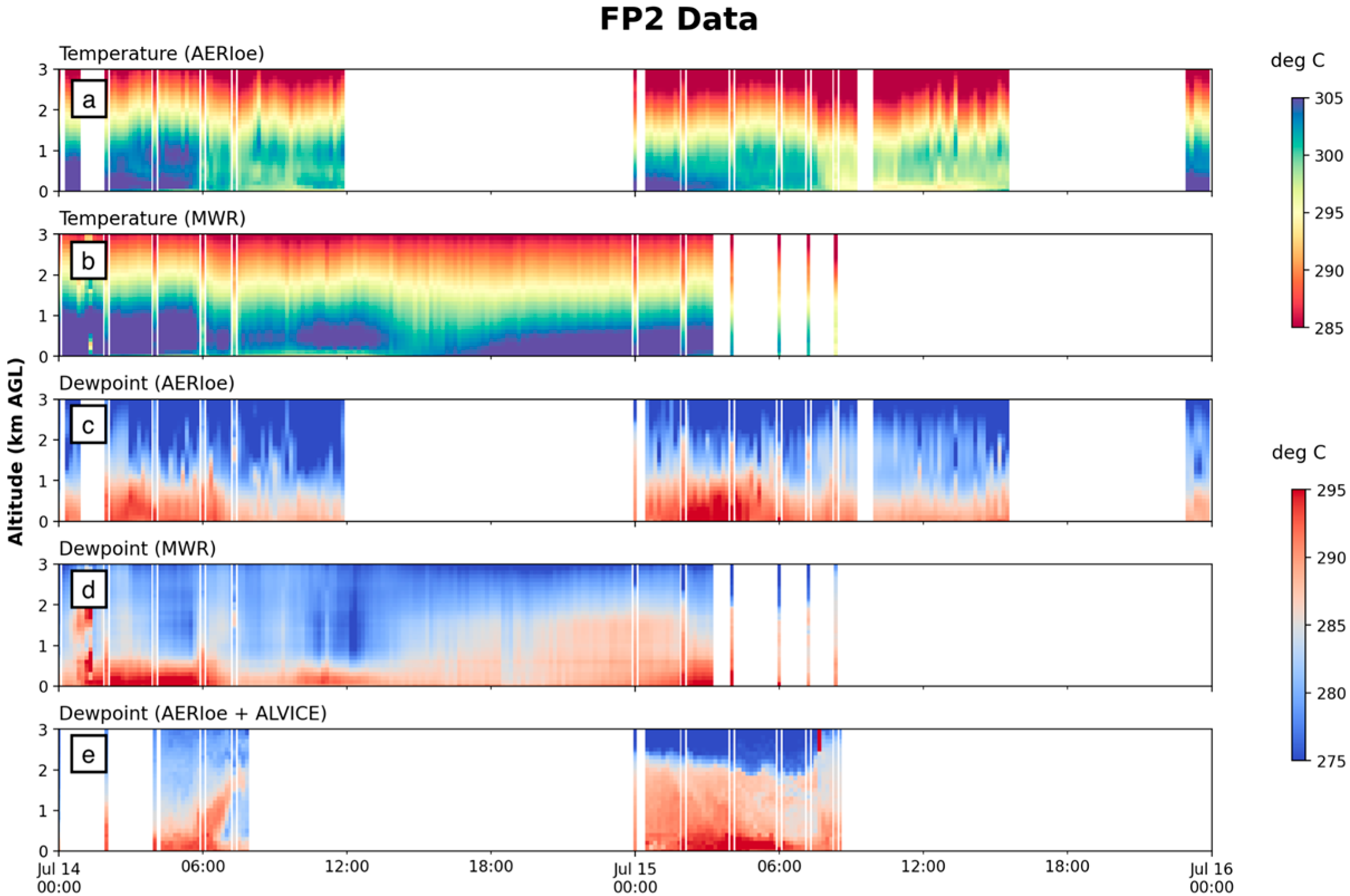

Appendix B
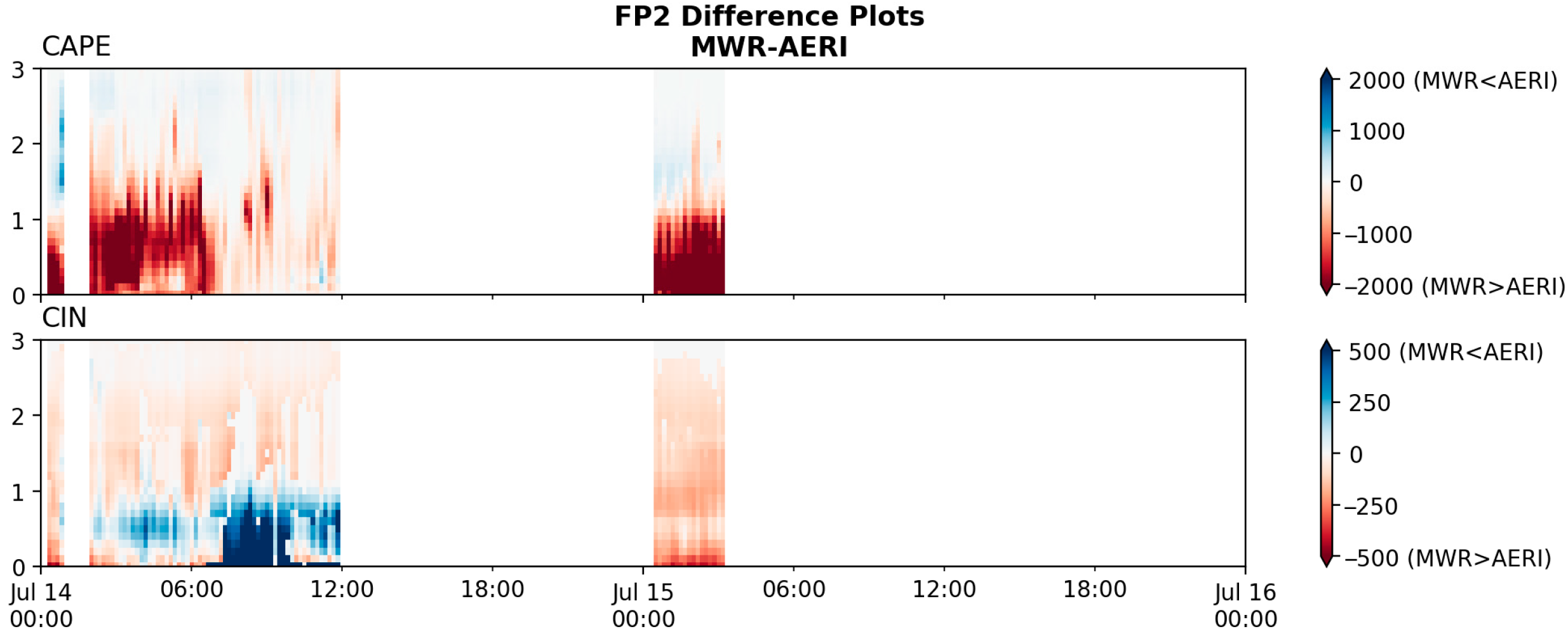


References
- Weckwerth, T.M.; Hanesiak, J.; Wilson, J.W.; Trier, S.B.; Degelia, S.K.; Gallus, W.A., Jr.; Roberts, R.D.; Wang, X. Nocturnal Convection Initiation during PECAN 2015. Bull. Am. Meteorol. Soc. 2019, 100, 2223–2239. [Google Scholar] [CrossRef]
- Grant, L.D.; Kirsch, B.; Bukowski, J.; Falk, N.M.; Neumaier, C.A.; Sakradzija, M.; van den Heever, S.C.; Ament, F. How Variable Are Cold Pools? Geophys. Res. Lett. 2024, 51, e2023GL106784. [Google Scholar] [CrossRef]
- Grant, L.D.; van den Heever, S.C. Cold pool dissipation. J. Geophys. Res. Atmos. 2016, 121, 1138–1155. [Google Scholar] [CrossRef]
- Hirt, M.; Craig, G.C.; Schäfer, S.A.K.; Savre, J.; Heinze, R. Cold-pool-driven convective initiation: Using causal graph analysis to determine what convection-permitting models are missing. Q. J. R. Meteorol. Soc. 2020, 146, 2205–2227. [Google Scholar] [CrossRef]
- Melfi, S.H.; Whiteman, D.; Ferrare, R. Observation of Atmospheric Fronts Using Raman Lidar Moisture Measurements. J. Appl. Meteorol. Climatol. 1989, 28, 789–806. [Google Scholar] [CrossRef]
- Turner, D.D.; Goldsmith, J.E.M. Twenty-Four-Hour Raman Lidar Water Vapor Measurements during the Atmospheric Radiation Measurement Program’s 1996 and 1997 Water Vapor Intensive Observation Periods. J. Atmos. Ocean. Technol. 1999, 16, 1062–1076. [Google Scholar] [CrossRef]
- Sakai, T.; Nagai, T.; Matsumura, T.; Nakazato, M.; Sasaoka, M. Vertical Structure of a Nonprecipitating Cold Frontal Head as Revealed by Raman Lidar and Wind Profiler Observations. J. Meteorol. Soc. Japan. Ser. II 2005, 83, 293–304. [Google Scholar] [CrossRef]
- Friedrich, K.; Kingsmill, D.E.; Flamant, C.; Murphey, H.V.; Wakimoto, R.M. Kinematic and Moisture Characteristics of a Nonprecipitating Cold Front Observed during IHOP. Part II: Alongfront Structures. Mon. Weather. Rev. 2008, 136, 3796–3821. [Google Scholar] [CrossRef]
- Grasmick, C.; Geerts, B.; Turner, D.D.; Wang, Z.; Weckwerth, T.M. The Relation between Nocturnal MCS Evolution and Its Outflow Boundaries in the Stable Boundary Layer: An Observational Study of the 15 July 2015 MCS in PECAN. Mon. Weather. Rev. 2018, 146, 3203–3226. [Google Scholar] [CrossRef]
- Demirgian, J.; Dedecker, R. Atmospheric Emitted Radiance Interferometer (AERI) Handbook; DOE/SC-ARM/TR-054; PNNL: Richland, WA, USA, 2005. [CrossRef]
- Knuteson, R.O.; Revercomb, H.E.; Best, F.A.; Ciganovich, N.C.; Dedecker, R.G.; Dirkx, T.P.; Ellington, S.C.; Feltz, W.F.; Garcia, R.K.; Howell, H.B.; et al. Atmospheric Emitted Radiance Interferometer. Part II: Instrument Performance. J. Atmos. Ocean. Technol. 2004, 21, 1777–1789. [Google Scholar] [CrossRef]
- Ferrare, R.; Nehrir, A.; Kooi, S.; Butler, C.; Notari, A. NASA DC-8 LASE Data, version 1.0; UCAR/NCAR—Earth Observing Laboratory: Boulder, CO, USA, 2016. [Google Scholar] [CrossRef]
- Spuler, S.M.; Repasky, K.S.; Morley, B.; Moen, D.; Hayman, M.; Nehrir, A.R. Field-deployable diode-laser-based differential absorption lidar (DIAL) for profiling water vapor. Atmos. Meas. Tech. 2015, 8, 1073–1087. [Google Scholar] [CrossRef]
- Fairless, T.; Jensen, M.; Zhou, A.; Giangrande, S.E. Interpolated Sounding and Gridded Sounding Value-Added Products; DOE/SC-ARM-TR-183; Pacific Northwest National Lab. (PNNL): Richland, WA, USA, 2021. [CrossRef]
- Whiteman, D. FP2 NASA/GSFC ALVICE Raman Lidar Data and Imagery, version 1.0; UCAR/NCAR—Earth Observing Laboratory: Boulder, CO, USA, 2016. [Google Scholar] [CrossRef]
- Demoz, B. FP2 Howard University Profiling Microwave Radiometer Data, version 2.0; UCAR/NCAR—Earth Observing Laboratory: Boulder, CO, USA, 2016. [Google Scholar] [CrossRef]
- National Academies of Sciences, Engineering, and Medicine; Division on Engineering, Physical Sciences; Space Studies Board; Committee on the Decadal Survey for Earth Science and Applications from Space. Thriving on Our Changing Planet: A Decadal Strategy for Earth Observation from Space; National Academies Press: Washington, DC, USA, 2018. [Google Scholar] [CrossRef]
- Teixeira, J.; Piepmeier, J.R.; Nehrir, A.R.; Ao, C.O.; Chen, S.S.; Clayson, C.A.; Fridlind, A.M.; Lebsock, M.; McCarty, W.; Salmun, H.; et al. Toward a Global Planetary Boundary Layer Observing System: The NASA PBL Incubation Study Team Report; NASA PBL Incubation Study Team: La Cañada Flintridge, CA, USA, 2021; p. 134.
- Wulfmeyer, V.; Hardesty, R.M.; Turner, D.D.; Behrendt, A.; Cadeddu, M.P.; Di Girolamo, P.; Schlüssel, P.; Van Baelen, J.; Zus, F. A review of the remote sensing of lower tropospheric thermodynamic profiles and its indispensable role for the understanding and the simulation of water and energy cycles. Rev. Geophys. 2015, 53, 819–895. [Google Scholar] [CrossRef]
- Haghi, K.R.; Geerts, B.; Chipilski, H.G.; Johnson, A.; Degelia, S.; Imy, D.; Parsons, D.B.; Adams-Selin, R.D.; Turner, D.D.; Wang, X. Bore-ing into Nocturnal Convection. Bull. Am. Meteorol. Soc. 2019, 100, 1103–1121. [Google Scholar] [CrossRef]
- Ferrare, R.A.; Browell, E.V.; Ismail, S.; Kooi, S.A.; Brasseur, L.H.; Brackett, V.G.; Clayton, M.B.; Barrick, J.D.; Diskin, G.S.; Goldsmith, J.E.; et al. Characterization of Upper-Troposphere Water Vapor Measurements during AFWEX Using LASE. J. Atmos. Ocean. Technol. 2004, 21, 1790–1808. [Google Scholar] [CrossRef]
- Ismail, S.; Ferrare, R.; Browell, E.; Kooi, S.; Biswas, M.; Krishnamurti, T.N.; Notari, A.; Heymsfield, A.; Butler, C.; Burton, S.; et al. LASE Observations of Interactions Between African Easterly Waves and the Saharan Air Layer. In Proceedings of the 25th International Laser Radar Conference, Saint Petersburg, Russia, 5–9 July 2010; Available online: https://ntrs.nasa.gov/citations/20100026001 (accessed on 2 May 2025).
- Hersbach, H.; Bell, B.; Berrisford, P.; Hirahara, S.; Horányi, A.; Muñoz-Sabater, J.; Nicolas, J.; Peubey, C.; Radu, R.; Schepers, D.; et al. The ERA5 global reanalysis. Q. J. R. Meteorol. Soc. 2020, 146, 1999–2049. [Google Scholar] [CrossRef]
- Haghi, K.R.; Durran, D.R. On the Dynamics of Atmospheric Bores. J. Atmos. Sci. 2021, 78, 313–327. [Google Scholar] [CrossRef]
- Knupp, K. Observational Analysis of a Gust Front to Bore to Solitary Wave Transition within an Evolving Nocturnal Boundary Layer. J. Atmos. Sci. 2006, 63, 2016–2035. [Google Scholar] [CrossRef]
- Clarke, R.H.; Smith, R.K.; Reid, D.G. The Morning Glory of the Gulf of Carpentaria: An Atmospheric Undular Bore. Mon. Weather. Rev. 1981, 109, 1726–1750. [Google Scholar] [CrossRef]
- Demoz, B.; Carroll, B.J.; Delgado, R.; Vermeesch, K.; Whiteman, D. Thermodynamic Profiling during Undular Bore and Cold Pool Conditions at PECAN FP2. In Proceedings of the 98th American Meteorological Society Annual Meeting, AMS, Austin, TX, USA, 7–11 January 2018; Available online: https://ams.confex.com/ams/98Annual/meetingapp.cgi/Paper/335148 (accessed on 1 June 2025).
- Yang, Z.; Whiteman, D.N.; Chen, X.; Zhang, Y.; Demoz, B.; Fuentes, J.D.; Ichoku, C.; Wilkins, J.L. Assimilating Radar and Lidar Observations to Improve the Prediction of Bore Waves During the 2015 PECAN Field Campaign. In Proceedings of the 30th International Laser Radar Conference, Big Sky, MT, USA, 26 June–1 July 2022; Sullivan, J.T., Leblanc, T., Tucker, S., Demoz, B., Eloranta, E., Hostetler, C., Ishii, S., Mona, L., Moshary, F., Papayannis, A., et al., Eds.; Springer International Publishing: Cham, Switzerland, 2023; pp. 849–858. [Google Scholar] [CrossRef]
- Turner, D.D.; Blumberg, W.G. Improvements to the AERIoe Thermodynamic Profile Retrieval Algorithm. IEEE J. Sel. Top. Appl. Earth Obs. Remote Sens. 2019, 12, 1339–1354. [Google Scholar] [CrossRef]
- Yang, Z. Assimilation of Lidar Profilers to Improve Bore Forecasts during the PECAN Campaign 2015. In Proceedings of the American Meteorological Society Annual Meeting, New Orleans, LA, USA, 12–16 January 2025. [Google Scholar]
- Skamarock, W.C.; Klemp, J.B. A time-split nonhydrostatic atmospheric model for weather research and forecasting applications. J. Comput. Phys. 2008, 227, 3465–3485. [Google Scholar] [CrossRef]
- Thompson, G.; Field, P.R.; Rasmussen, R.M.; Hall, W.D. Explicit Forecasts of Winter Precipitation Using an Improved Bulk Microphysics Scheme. Part II: Implementation of a New Snow Parameterization. Mon. Weather. Rev. 2008, 136, 5095–5115. [Google Scholar] [CrossRef]
- May, R.M.; Arms, S.C.; Marsh, P.; Bruning, E.; Leeman, J.R.; Goebbert, K.; Thielen, J.E.; Bruick, Z.; Camron, M.D. MetPy: A Python Package for Meteorological Data. Unidata/MetPy. 2025. Available online: https://www.unidata.ucar.edu/software/metpy/ (accessed on 1 June 2025).

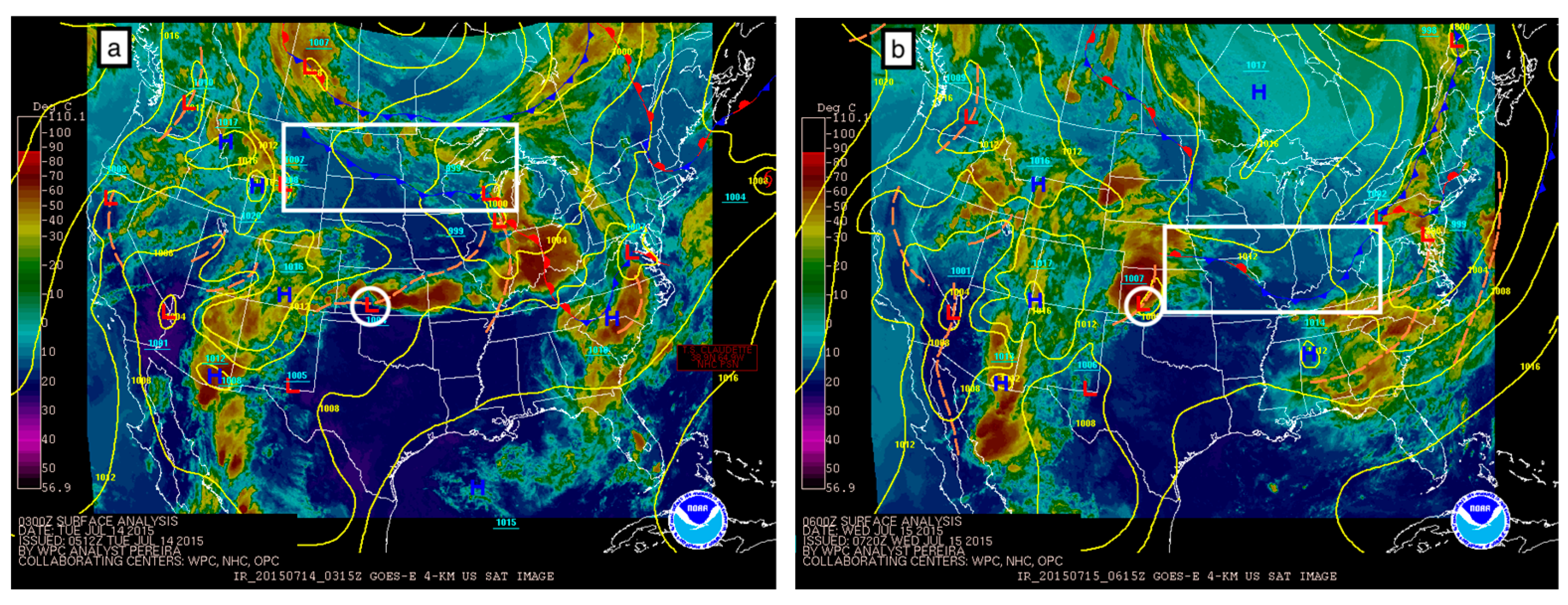


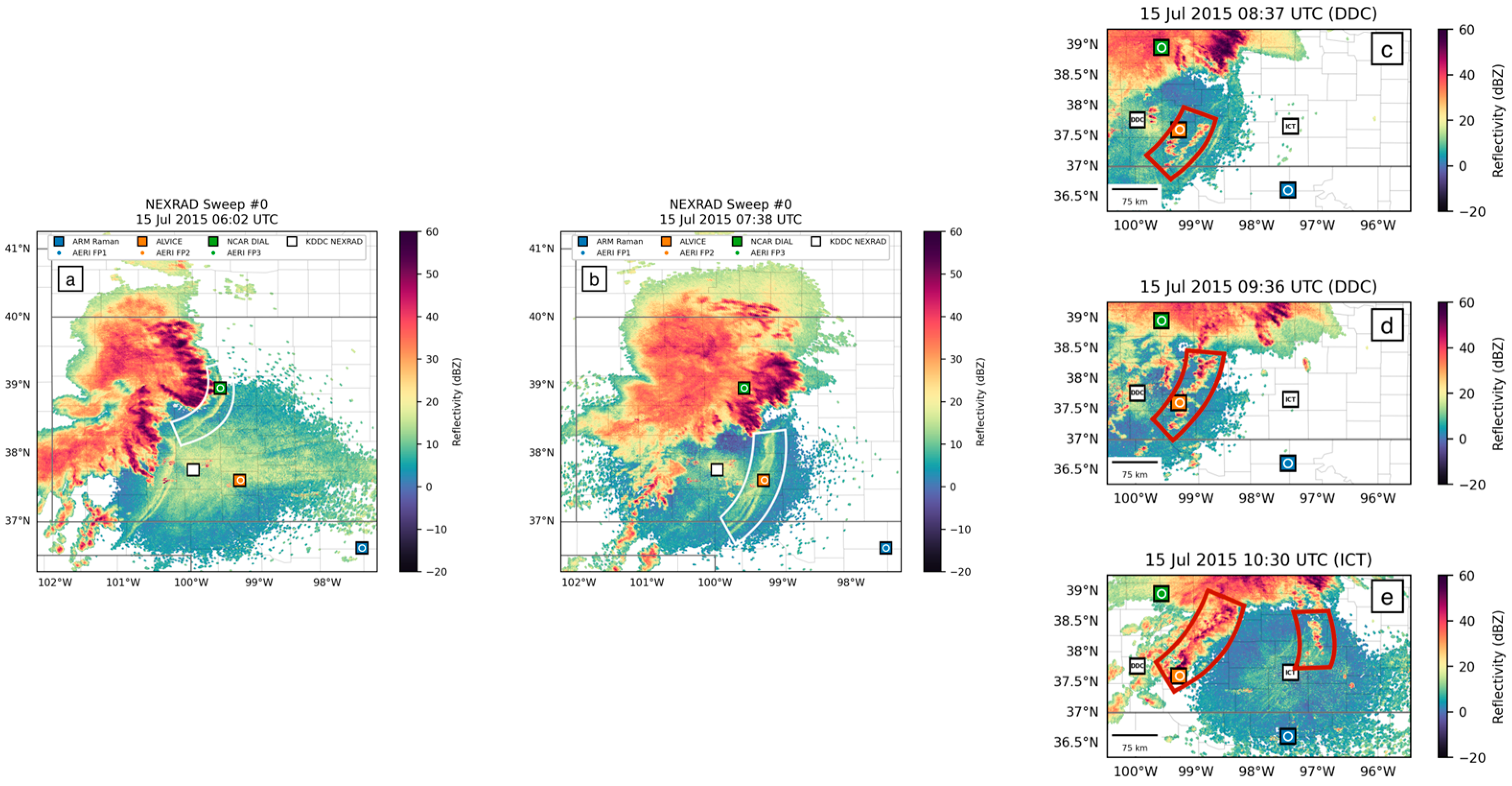
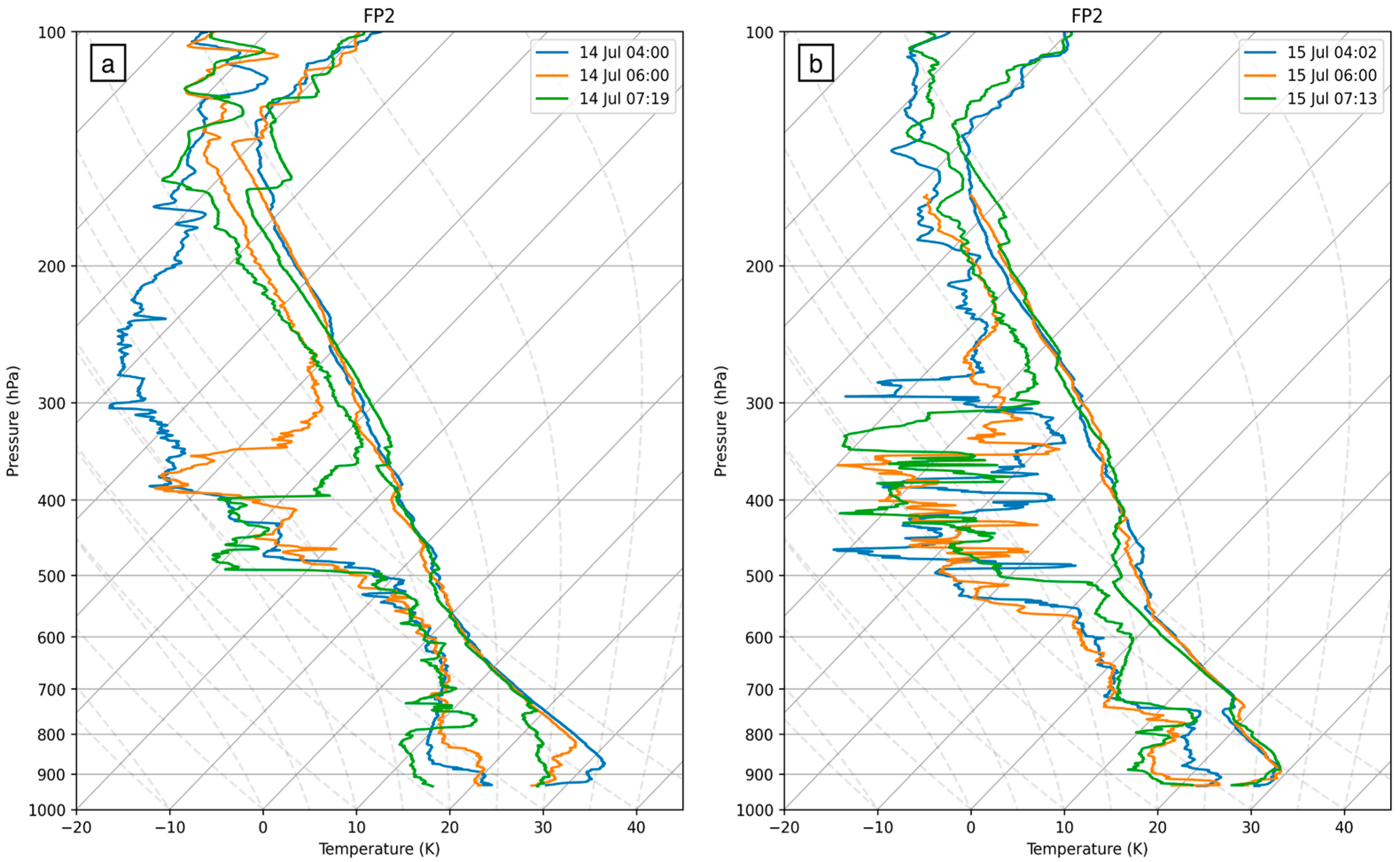
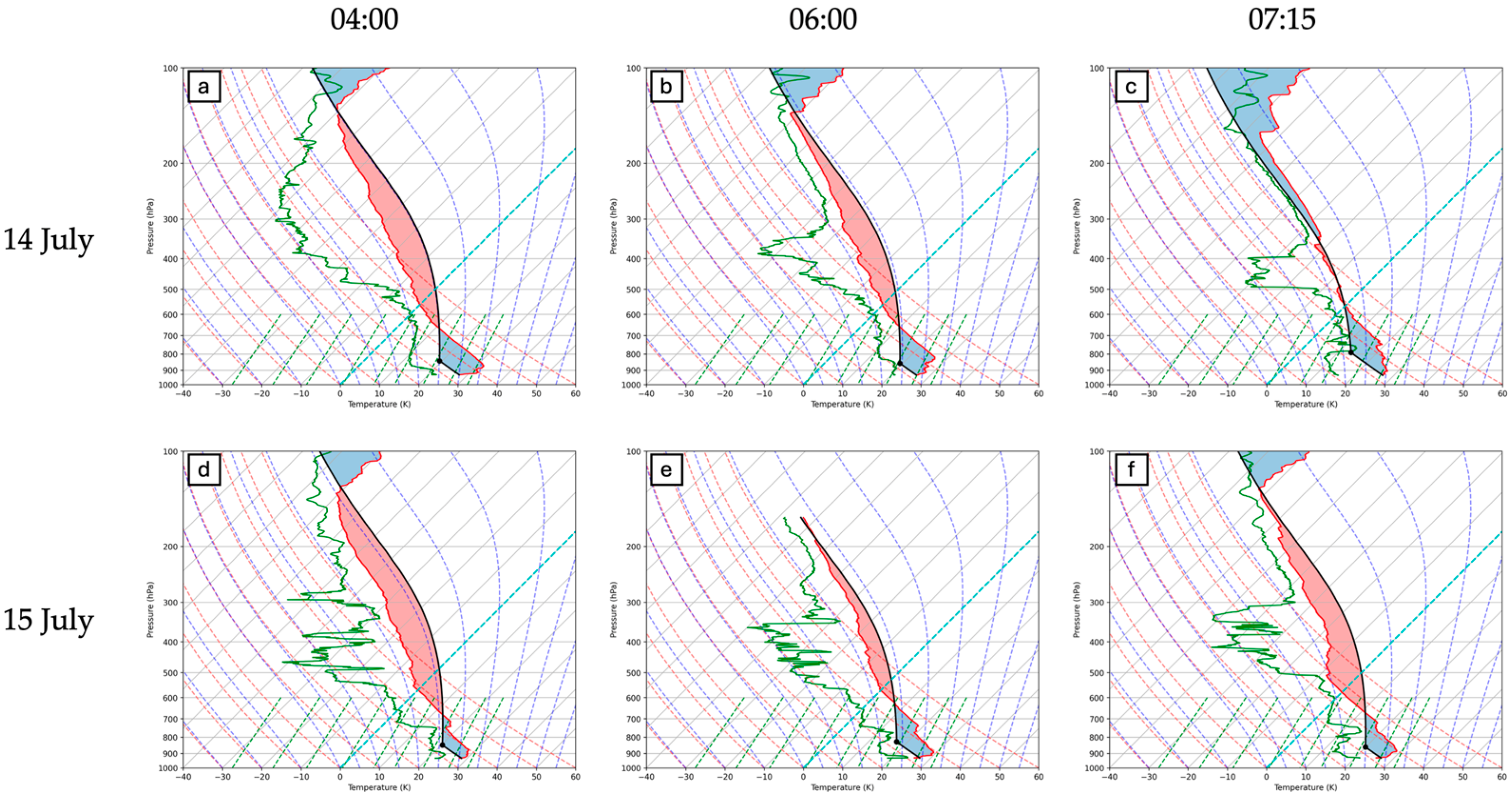
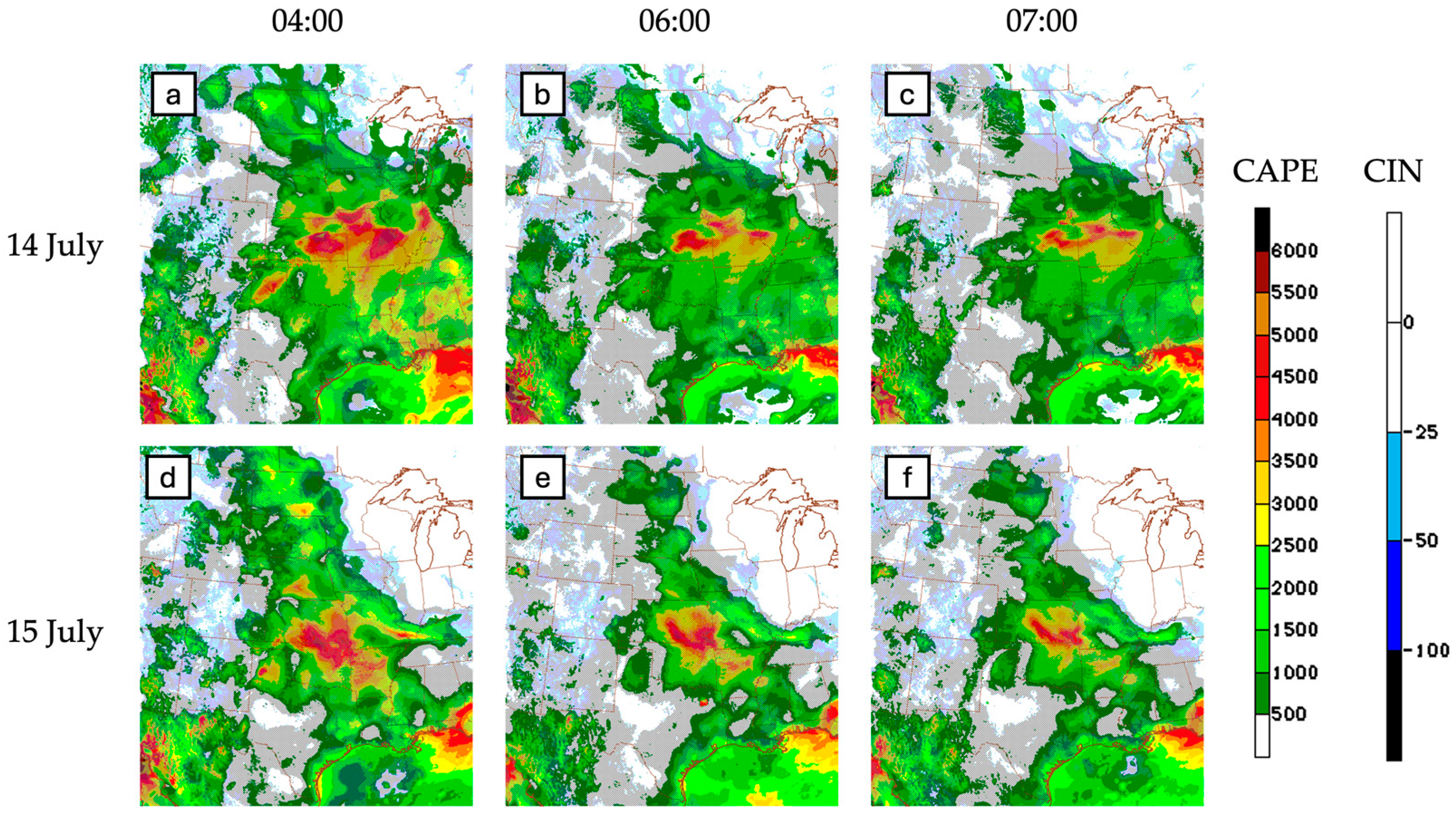
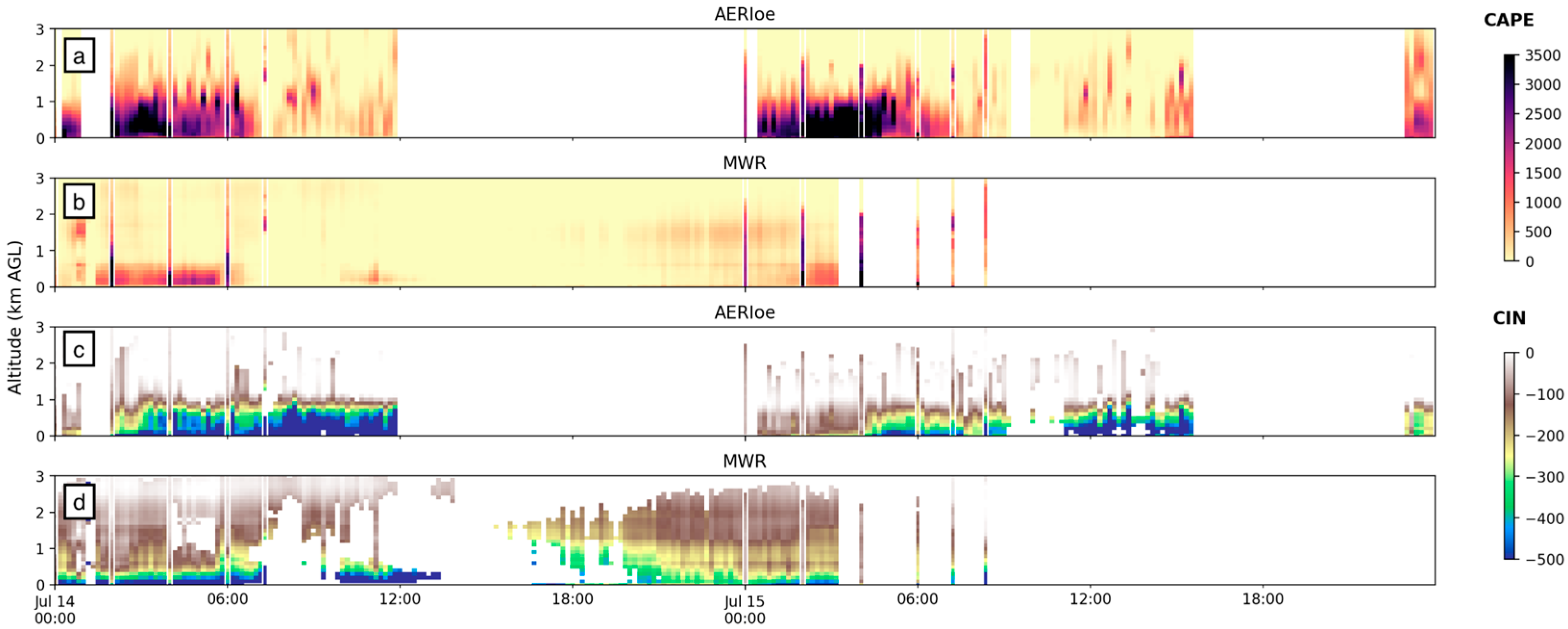
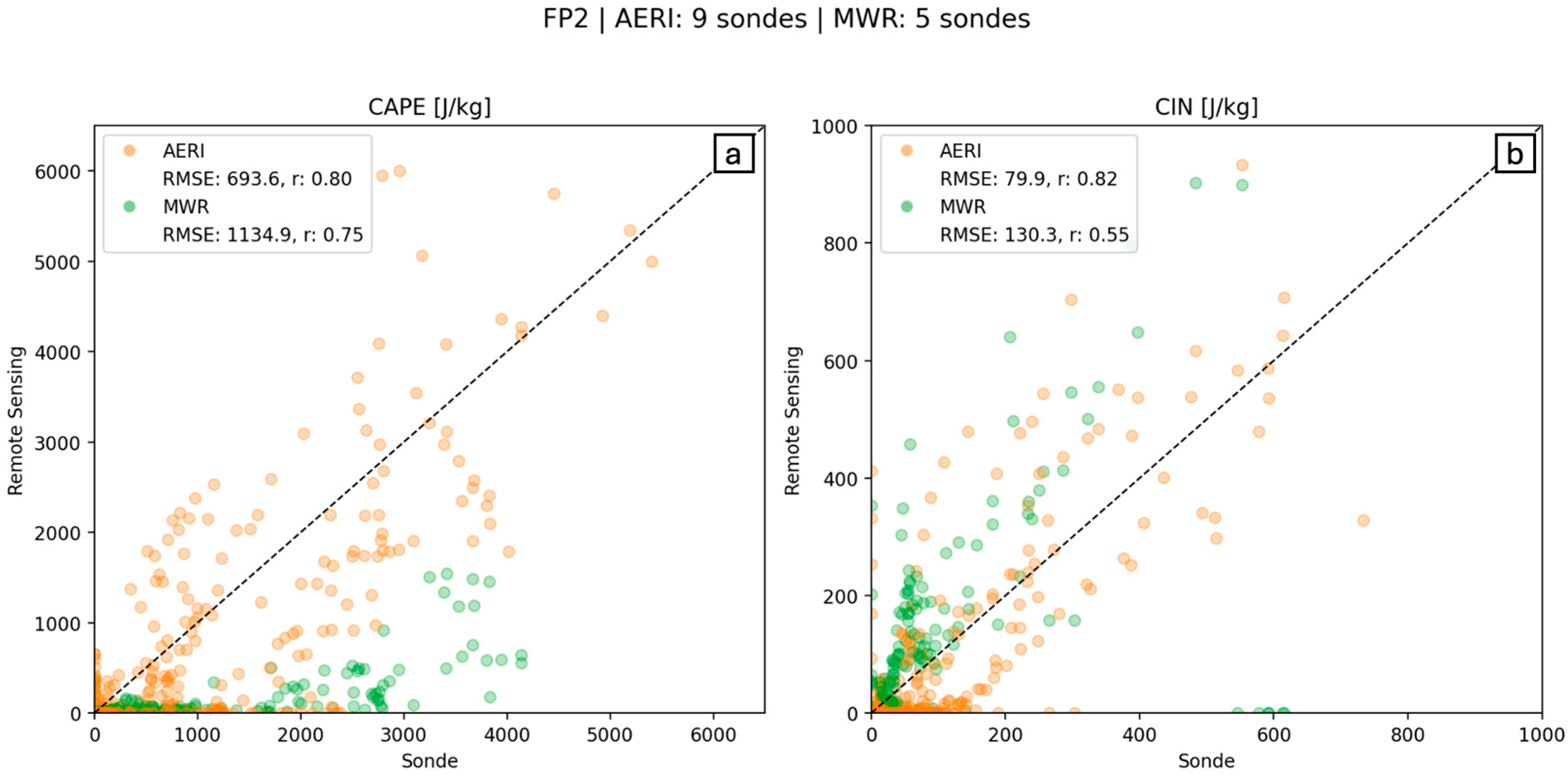
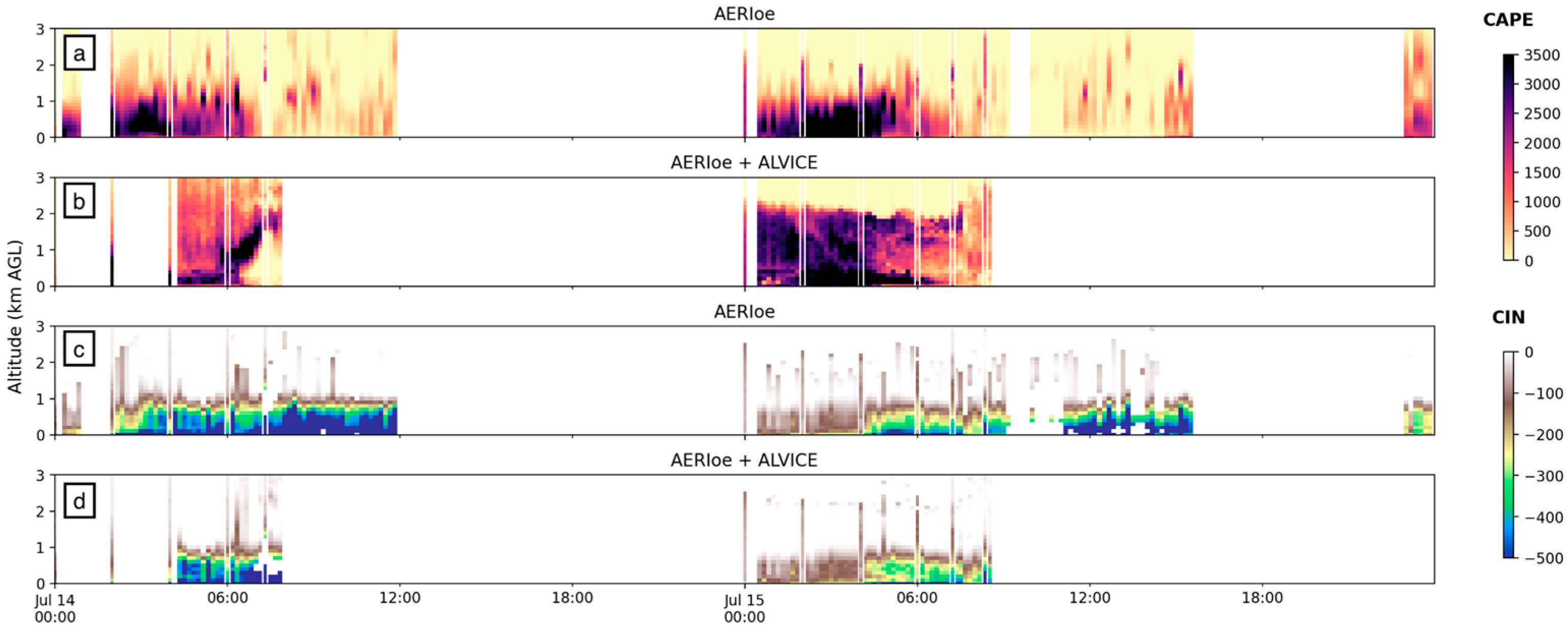


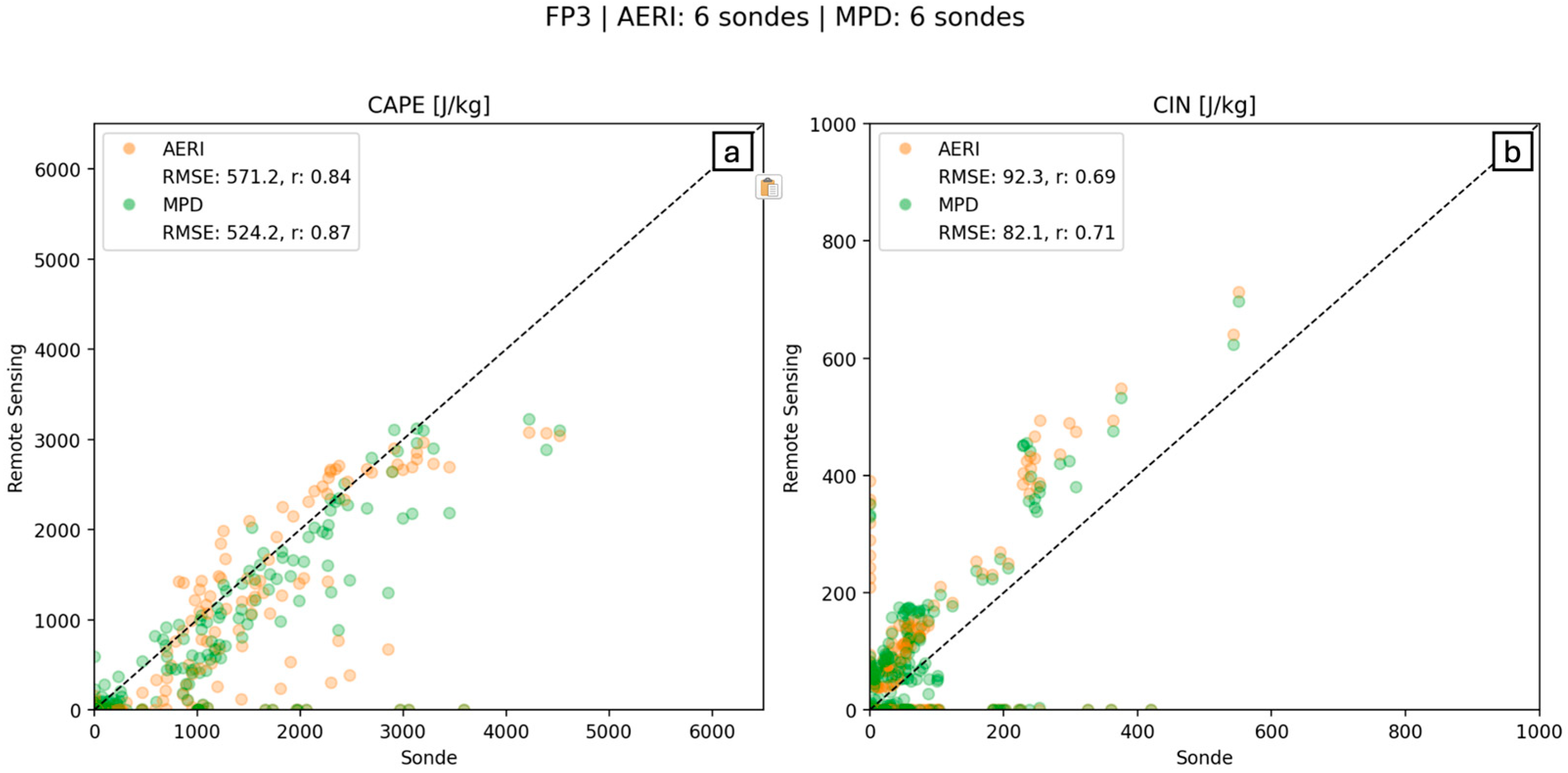
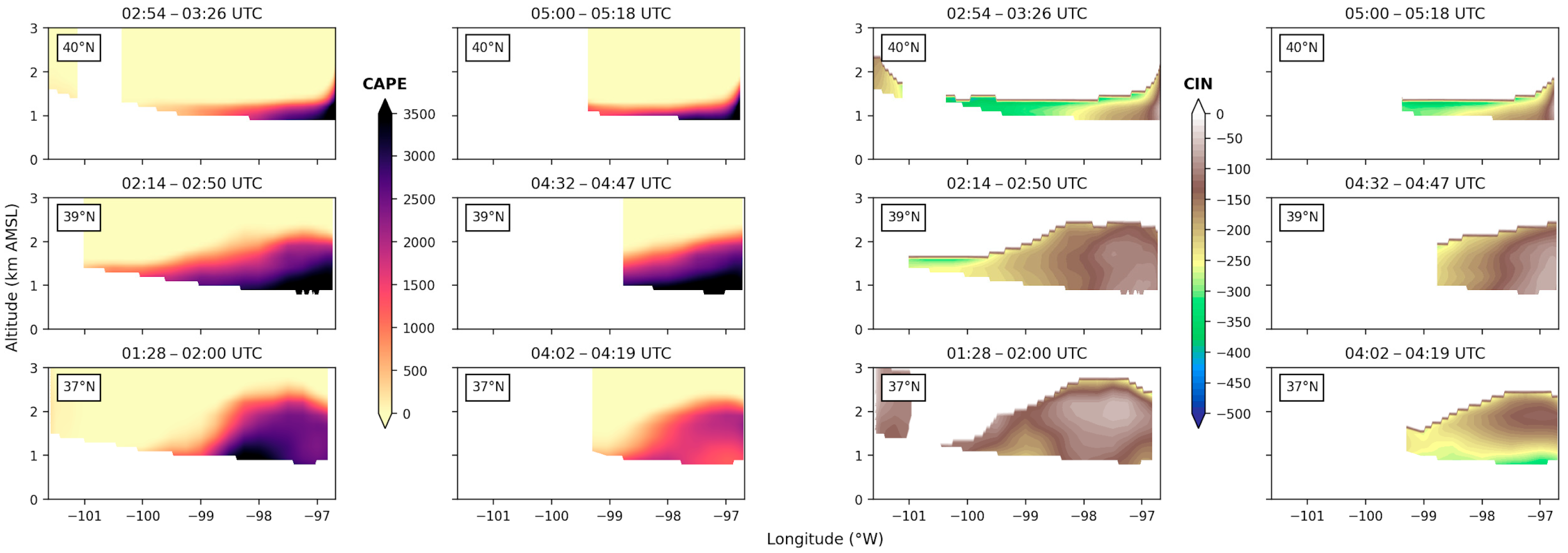
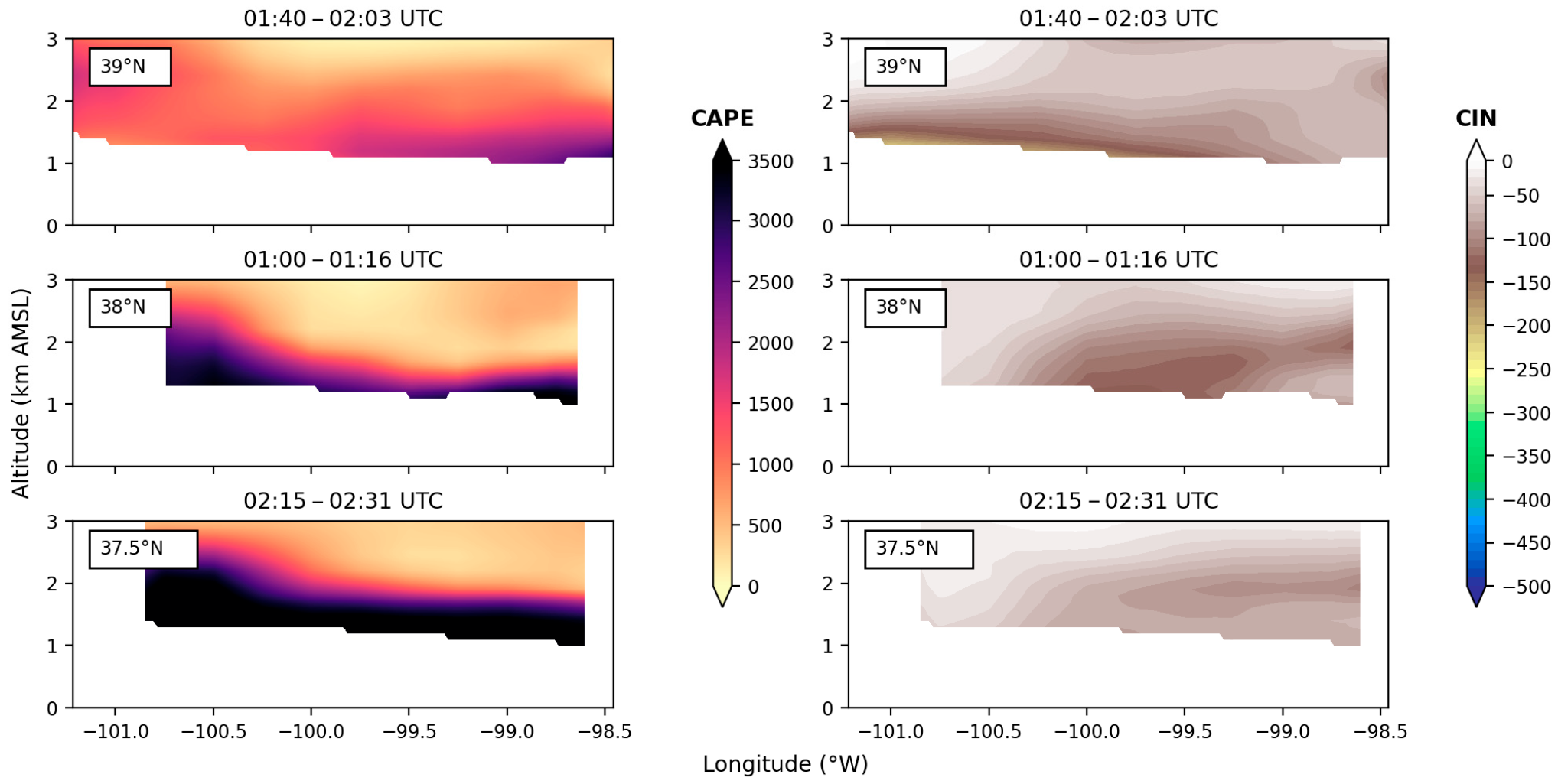

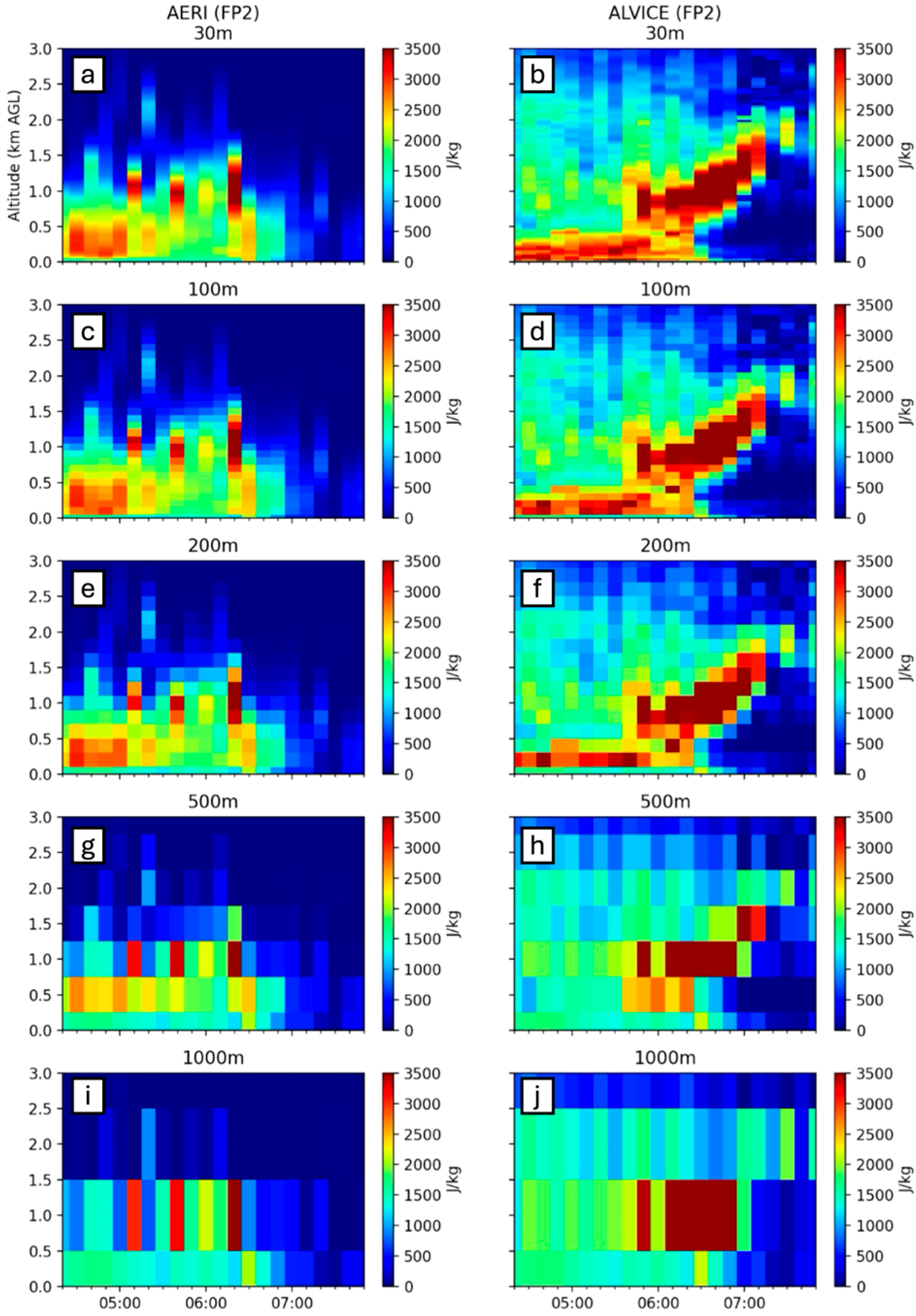
| Instrument | Type | Vertical Resolution | Temporal Resolution |
|---|---|---|---|
| AERI 1 | Passive | 100+ m | 8 min |
| LASE (airborne) DIAL 2 | Active | 30 m | 3 min |
| MicroPulse (ground-based) DIAL 3 | Active | 75 m | 30 s |
| Radiosonde 4 | In Situ | 20–500 m | |
| ALVICE 5 | Active | 30 m | 30 s |
| Microwave Radiometer 6 | Passive | 50 m | 2 min |
| Objective (Importance) | Variable | Horizontal Resolution | Vertical Resolution | Temporal Resolution |
|---|---|---|---|---|
| W-1a (MI) Determine the effects of key boundary layer processes on weather, hydrological, and air quality forecasts at minutes to subseasonal time scales | T, q profiles | 20 km | 200 m | 3 h |
| PBLH | 20 km | 100 m | 3 h | |
| W-2a (MI) Improve the observed and modeled representation of natural, low-frequency modes of weather/climate variability (e.g., MJO, ENSO) | T, q profiles | 3–5 km | 1 km | 1–3 h |
| W-3a (VI) Determine how spatial variability in surface characteristics modifies regional cycles of energy, water, and momentum (stress) … and observe total precipitation to an average accuracy of 15% over oceans and/or 25% over land and ice surfaces | PBLH | 5–10 km | 10 m | 1–2/day |
| W-4a (MI) Measure the vertical motion within deep convection to within 1 m/s and heavy precipitation rates to within 1 mm/hour to improve model representation of extreme precipitation and to determine convective transport and redistribution of mass, moisture, momentum, and chemical species | q profiles | 1 km | 500 m | 15 m |
| W-10a (I) Quantify the effects of clouds of all scales on radiative fluxes, including on the boundary layer evolution. Determine the structure, evolution, and physical/dynamical properties of clouds | cloud fraction | 200 m | -- | -- |
| Instrument/Data | Temperature | Dewpoint | Pressure |
|---|---|---|---|
| AERI | ✓ | ✓ | ✓ |
| ALVICE (Raman LiDAR) | FP2 AERI used | q 1 → Td | ✓ |
| NCAR MPD (DIAL) | FP3 AERI used | (n/V) 2 → Td | ✓ |
| Microwave Radiometer | ✓ | RH 3 → Td | z → P |
| LASE DIAL (Airborne) | ERA5 used | q 1 → Td | z → P |
| ERA5 (Reanalysis) | ✓ | RH 3 → Td | ✓ |
Disclaimer/Publisher’s Note: The statements, opinions and data contained in all publications are solely those of the individual author(s) and contributor(s) and not of MDPI and/or the editor(s). MDPI and/or the editor(s) disclaim responsibility for any injury to people or property resulting from any ideas, methods, instructions or products referred to in the content. |
© 2025 by the authors. Licensee MDPI, Basel, Switzerland. This article is an open access article distributed under the terms and conditions of the Creative Commons Attribution (CC BY) license (https://creativecommons.org/licenses/by/4.0/).
Share and Cite
Hoffman, K.; Demoz, B. Convection Parameters from Remote Sensing Observations over the Southern Great Plains. Sensors 2025, 25, 4163. https://doi.org/10.3390/s25134163
Hoffman K, Demoz B. Convection Parameters from Remote Sensing Observations over the Southern Great Plains. Sensors. 2025; 25(13):4163. https://doi.org/10.3390/s25134163
Chicago/Turabian StyleHoffman, Kylie, and Belay Demoz. 2025. "Convection Parameters from Remote Sensing Observations over the Southern Great Plains" Sensors 25, no. 13: 4163. https://doi.org/10.3390/s25134163
APA StyleHoffman, K., & Demoz, B. (2025). Convection Parameters from Remote Sensing Observations over the Southern Great Plains. Sensors, 25(13), 4163. https://doi.org/10.3390/s25134163







